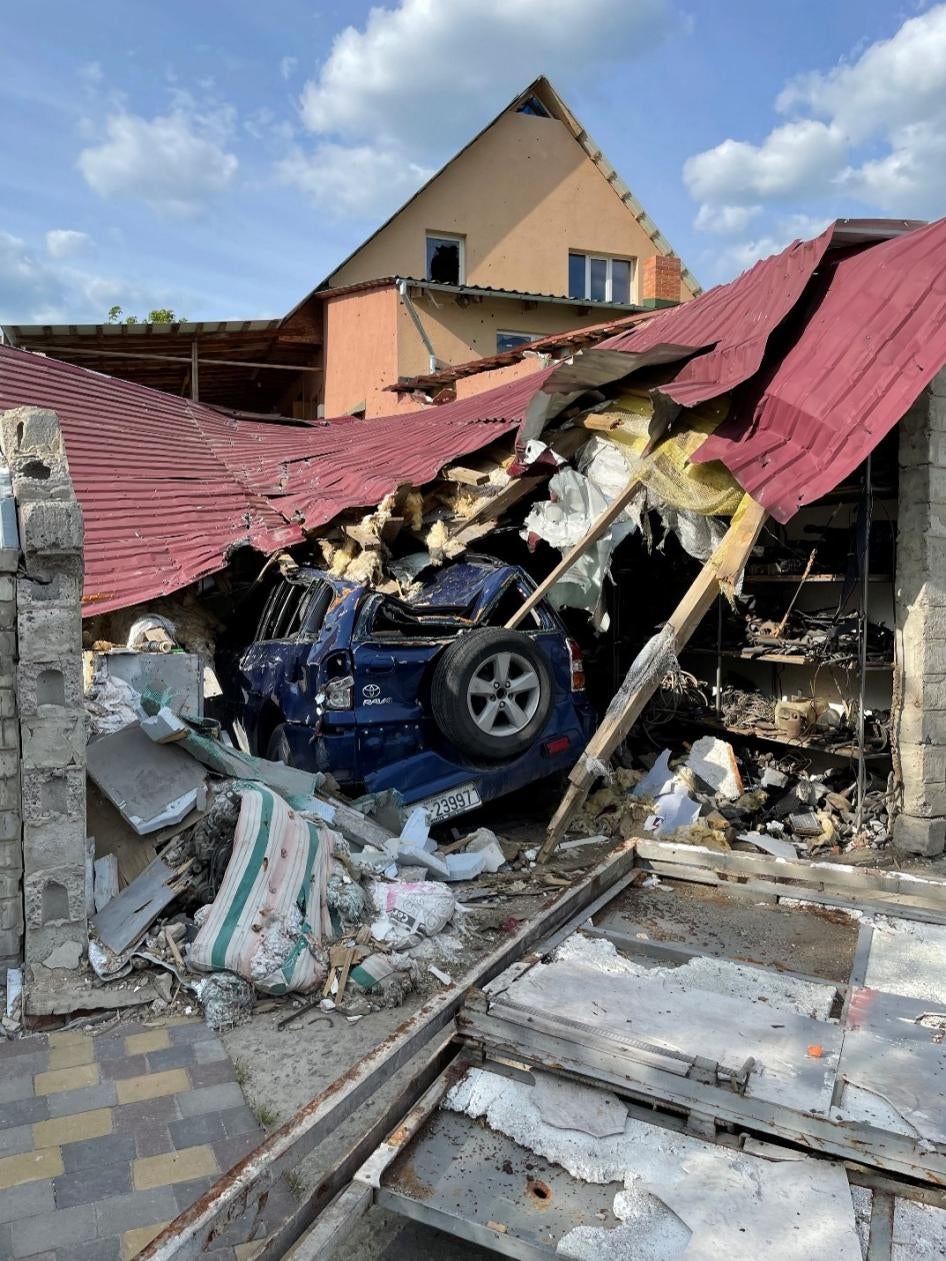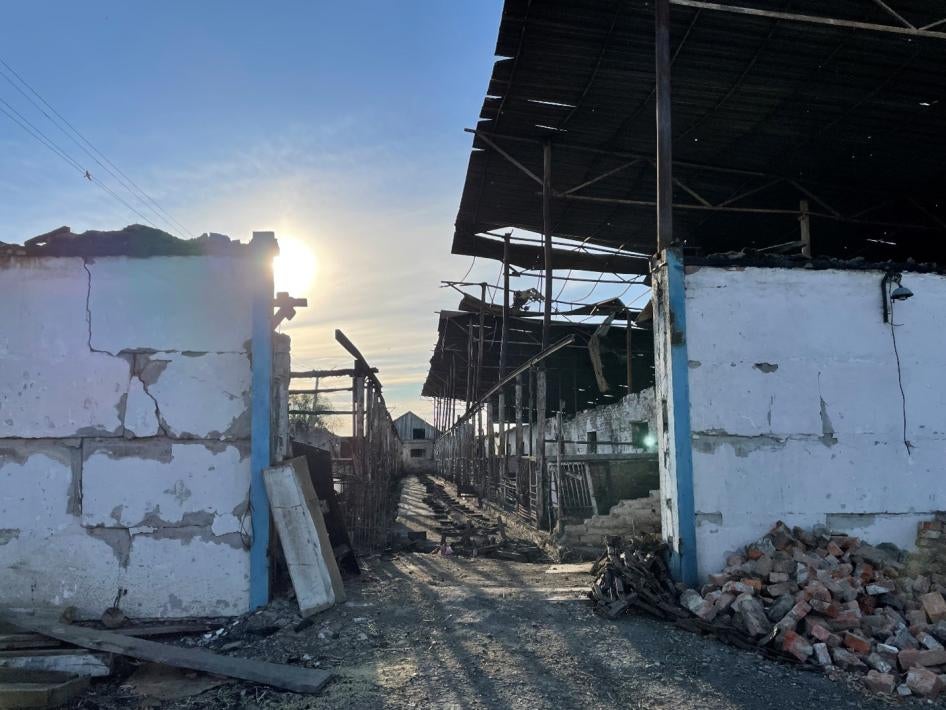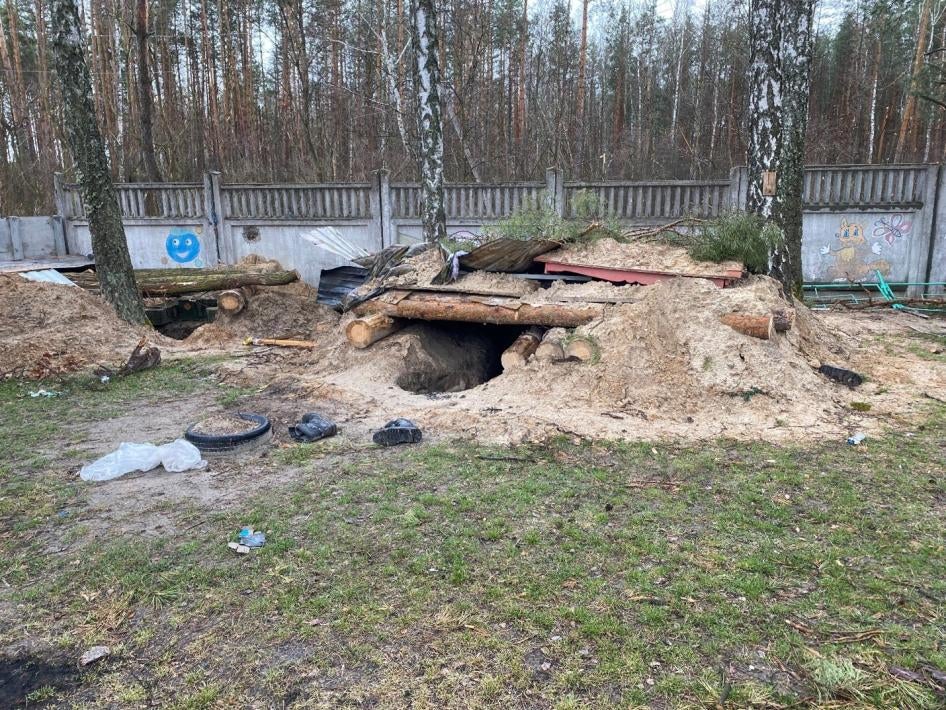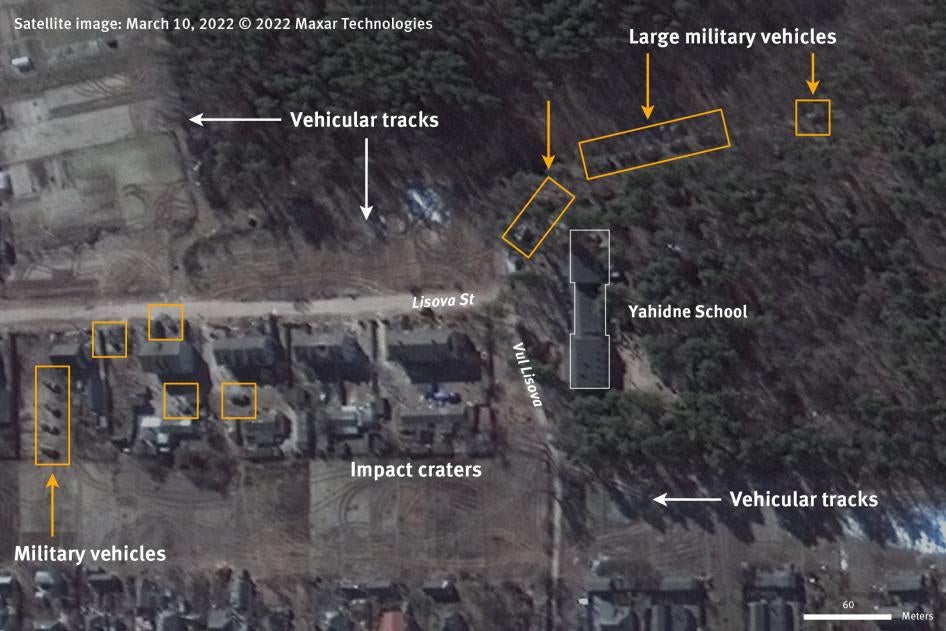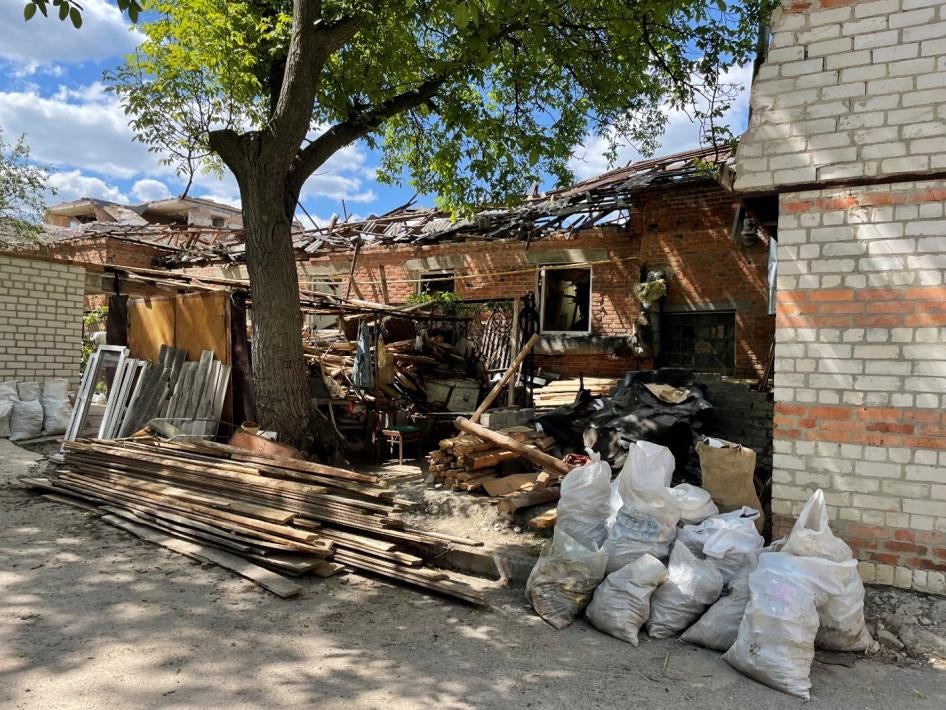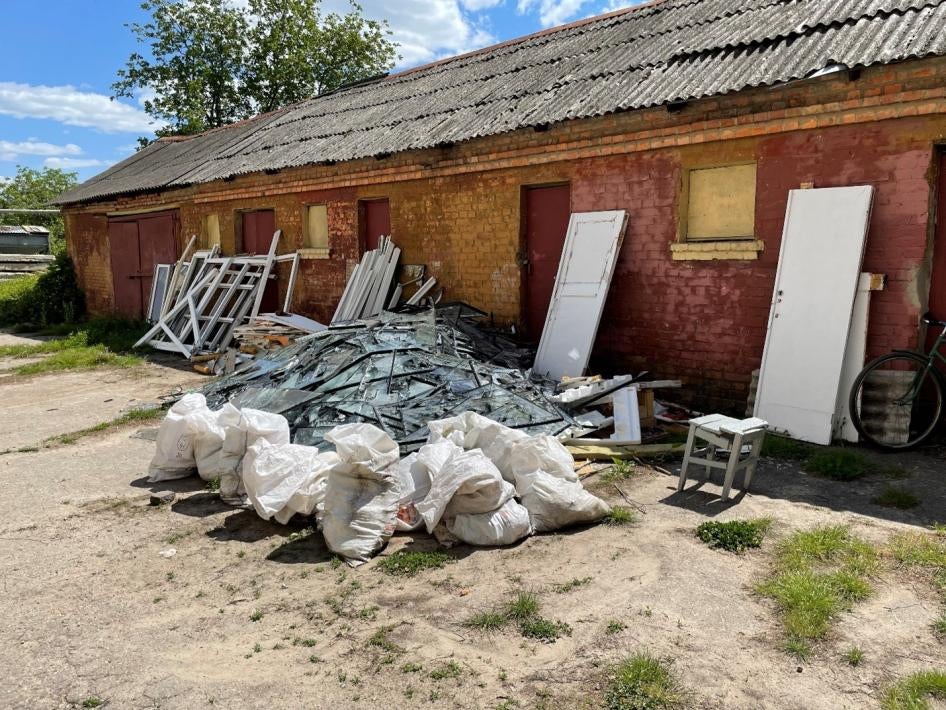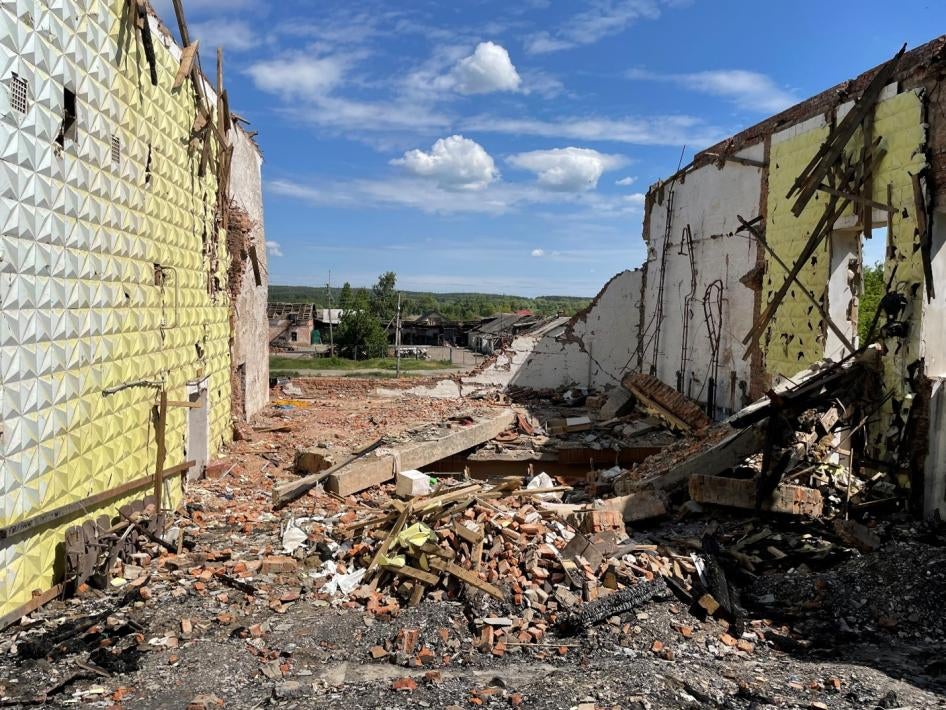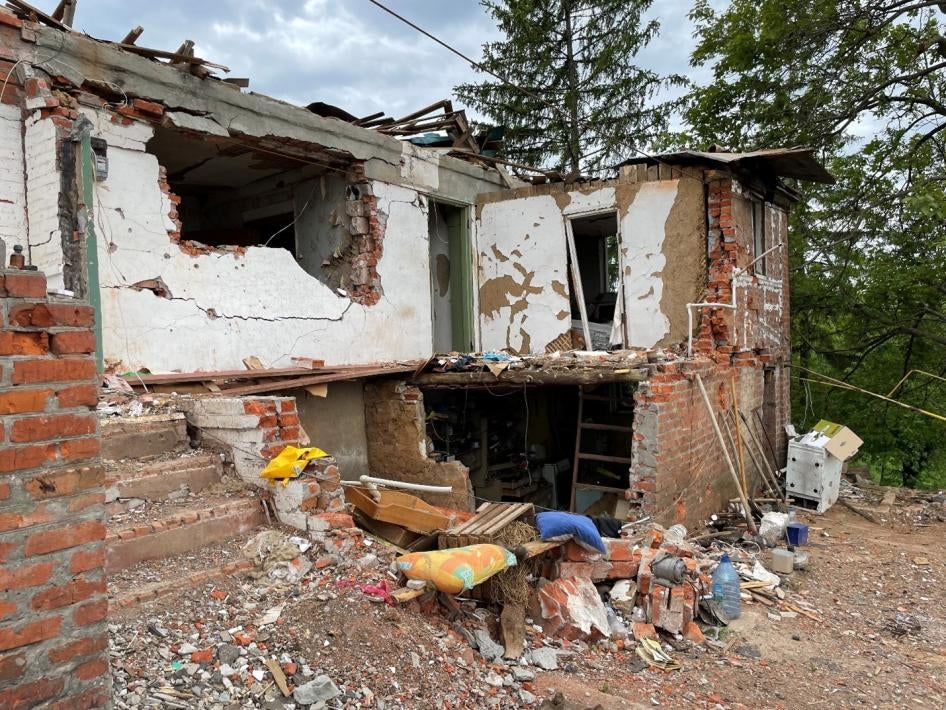Russian and Ukrainian forces have put civilians in Ukraine at unnecessary risk by basing their forces in populated areas without removing residents to safer areas, Human Rights Watch said today. International humanitarian law - the laws of war - obligates parties to the conflict to take all feasible precautions to protect civilians and civilian structures under their control from the effect of attacks.
In four cases that Human Rights Watch investigated, Russian forces established military bases in populated areas, needlessly endangering civilians. In three cases, Ukrainian forces based forces among homes where people were living but took no apparent action to move residents to safer areas. Ensuing attacks on these bases killed and wounded civilians. The International Committee of the Red Cross has noted several means of protecting civilians from attack, including: "the construction of shelters, digging of trenches, distribution of information and warnings, withdrawal of the civilian population to safe places, direction of traffic, guarding of civilian property and the mobilization of civil defence organizations."
"As the war in Ukraine rages on, civilians have been caught in the fighting unnecessarily," said Belkis Wille, senior crisis and conflict researcher at Human Rights Watch. "Russian and Ukrainian forces both need to avoid basing their troops among civilians, and to do all they can to remove civilians from the vicinity."
Between April 17 and May 31, 2022, Human Rights Watch interviewed 54 civilians in the towns and villages of Mykhailo-Kotsiubynske and Yahidne in the northern Chernihiv region; Malaya Rohan, Pokotylivka, Selekstiine, and Yakovlivka in the eastern Kharkiv region; and from Polohy in the southern Zaporizhzhia region. Researchers visited all of these locations except for Polohy due to ongoing fighting but interviewed residents who had fled the village.
In Yahidne, Russian forces unlawfully held nearly 350 civilians for a month in the basement of a schoolhouse near the front lines that the Russians used as a military base. Ukrainian attacks in those areas damaged homes and other structures.
In Malaya Rohan, Russian forces set up a base at a farm, where they parked dozens of military vehicles. The soldiers unlawfully prevented civilians from leaving the area. On March 26, an exchange of artillery fire resulted in damage to a nearby farm and the death of 140 livestock.
In Pokotylivka, Ukraine Territorial Defense Forces established a base at a disease control center in a residential neighborhood without taking steps to remove civilians from the area. When Russian forces attacked the center on April 28, at least six civilians were wounded, and dozens of nearby homes and the local school were damaged.
About 300 Ukrainian soldiers began using the cultural center in Selekstiine village as a barracks in early March without relocating civilians from the area. About 10 days later, a large munition hit the center, destroying it completely and damaging many surrounding buildings.
In late February, in Yakovlivka village, Ukrainian armed forces started using the local school and council buildings as a military base and barracks while civilians remained in the area. On March 2, multiple munitions hit the village, killing 4 civilians, wounding at least 10 others, and destroying and damaging dozens of homes.
Human Rights Watch wrote to the Russian and the Ukrainian Defense Ministries on May 6, asking for information on the steps their armed forces were taking to minimize civilian casualties, remove civilians from the vicinity of fighting, and avoid deploying forces in densely populated areas. Neither side has responded.
The laws of war applicable during the international armed conflict in Ukraine can be found in the Geneva Conventions of 1949, the First Additional Protocol to the Geneva Conventions (Protocol I), and customary international law. Article 58 of Protocol I on "precautions against the effects of attacks" requires parties to the conflict, "to the maximum extent feasible," to take the necessary precautions to protect civilians and civilian objects under their control from the dangers resulting from military operations; avoid locating military targets within or near densely populated areas; and seek to remove civilians and civilian objects under their control from the vicinity of military targets. Removing civilians must be consistent with laws-of-war prohibitions against forced transfers except for legitimate security reasons.
The Russian Federation's 2001 Regulations on the Application of International Humanitarian Law state: "To the greatest possible extent … precautions shall be taken to protect the civilian population, individual civilians and civilian objects against the effects of combat operations." Russia's permanent representative to the United Nations Security Council stated in 2008 that "The protection of civilians must be the highest priority for Governments involved in conflicts. We emphasize that all parties to armed conflict bear responsibility for ensuring the security of civilians."
Ukraine's 2004 International Humanitarian Law manual states:
Civilian persons and civilian objects shall be removed from the locations of military objectives. To that end commanders … shall take all measures to interact with local authorities. Removal of civilians from areas located near military objectives shall be performed to safe areas known to them. If circumstances permit, effective warning of the defensive actions affecting the civilian population shall be made in advance (e.g. for evacuation of persons from certain buildings or areas).
While attacking forces are not prevented from carrying out attacks on military targets if defending forces do not take all feasible precautions, they remain bound to take appropriate measures to minimize civilian harm, including not carrying out indiscriminate attacks or attacks that would be likely to cause disproportionate loss of civilian life or property.
"Russian and Ukrainian forces need to do all they can to help civilians in their midst get to safer locations or otherwise minimize their risk of being harmed," Wille said. "It's not enough to do nothing and hope civilians won't be harmed."
For details on seven situations investigated by Human Rights Watch, please see below.
Endangerment by Russian Forces
Malaya Rohan, Kharkiv Region
Russian forces took control of Malaya Rohan village, five kilometers east of Kharkiv, on February 27. Human Rights Watch researchers visited the village on May 24 and interviewed eight residents.
Vasyl Osmachko, 74, said that Russian forces set up a checkpoint near his home soon after they arrived, and that tanks regularly drove up and down his street. He and his neighbors said Russian forces never took any steps to evacuate the civilian population as the Russians set up their military presence in the village, and they did not let civilians through their checkpoints, preventing them from leaving the village or going to other neighborhoods.
Osmachko said that on March 17, at about 7 p.m., a Ukrainian attack hit a tank driving past his house, causing the tank to swerve to the side of the road. The attack severely damaged his garage, adjacent to his home, and his car parked inside. "I heard a loud bang as my body was lifted off the sofa," Osmachko said. "I tried to rush outside to see what had happened, but the door was blocked from the outside, so I stayed inside for the night, and the next morning I crawled out using the window."
Liubov Zlobina, who owns a farm on the outskirts of Malaya Rohan, said that when Russian forces first arrived in the village, they tried to seize her farm to use as a base. She told them they could not, given the large number of livestock at the farm and because 12 people were living there.
The soldiers instead set up a base at another farm about 200 meters away, and stayed there for a month, she said, with as many as three dozen military vehicles parked there at a time. They set up checkpoints, including near her farm, she said, and did not allow any residents to leave the village by car, though some escaped at night on foot.
On March 26, the day before Russian forces pulled out of the area, there was heavy shelling on the base, and Russian forces were firing from the base toward approaching Ukrainian forces. Zlobina said the attacks caused hay on her larger barn's roof to catch fire, burning the roof and part of the barn. She said she lost 140 livestock that day - calves, cows, rams, and pigs - in the fire, and researchers saw damage to other barns.
Mykhailo-Kotsiubynske, Chernihiv Region
Residents of the town of Mykhailo-Kotsiubynske, 12 kilometers west of Chernihiv city, said that Russian forces entered on February 28 and established a heavy military presence throughout the town, using its administration building as their headquarters. Nina Vorokh, the head of the local administration, said she could hear Russian forces firing ordnance from the town. "The din was continuous," she said. "When artillery shells fly, you feel it and it is scary."
Vorokh said that about 130 civilians sought shelter in the basement of the local school. Russian forces deployed armored vehicles next to the school, she and another resident said. The forces neither urged civilians to leave nor facilitated evacuations. The residents stayed in the basement until the school was hit on March 4. The strike damaged the building and killed one woman who worked at the school.
Polohy, Zaporizhzhia Region
Russian forces took control of Polohy village, near the city of Polohy, between March 3 and 7, several residents said. One man said that throughout March and the first half of April, groups of Russian soldiers approached some houses in the village, told the residents to leave, and lived in their homes for two to three days before moving into another house. Russian soldiers used his neighbor's house as their quarters for three days in March, he said. A female resident said that Russian forces set up a military headquarters in the Karona restaurant, in the middle of the village.
The man said that for much of March, Russian forces deployed four armored vehicles and set up Grad rocket launchers next to his home. Ukrainian munitions hit his house twice during that time, on March 12 and March 26, heavily damaging his roof and walls. He and his family fled the area in mid-April. Russian forces did not tell civilians to leave the area or facilitate their evacuation, he said.
Yahidne, Chernihiv Region
On around February 28, Russian forces arrived in Yahidne village, 15 kilometers south of Chernihiv city. They remained until Ukrainian forces briefly retook the village on March 1 before being pushed out again on March 3. On March 4, Russian forces told residents that they needed to shelter in the local school "for their own safety," a dozen villagers said. Some villagers refused and were allowed to remain in their homes because they were sick or caring for someone who was sick. But over 350 people sheltered in the school basement in cramped, unsanitary conditions until Russian forces left the area on March 31.
Russian soldiers severely limited people's ability to leave the basement, even for brief periods, arbitrarily depriving them of their liberty. The villagers said 10 older people died there, apparently due to sickness or from the poor conditions. The laws of war prohibit detaining civilians except for imperative security reasons. Those deprived of their liberty must be provided with adequate food, water, clothing, shelter, and medical attention.
During this period, Russian forces used the school as a military base and apparently attempted to hide military vehicles around the schoolhouse in dugouts and pits, which were still there when Human Rights Watch visited. A woman who was in the basement with her 8-year-old son said that she saw many soldiers at the school and numerous armored vehicles. The presence of Russian forces at the school, whether or not they fired munitions in the vicinity, made the school a legitimate military target, putting the civilians in the basement at grave risk.
A March 10 satellite image shows several dozen armored and support military vehicles in the schoolyard and large vehicle tracks throughout the village, with a higher concentration at the schoolhouse. Apparent impact craters are also visible in the village, the closest 60 meters northeast of the school. When researchers visited the school, they saw trenches and dugouts, wheeled and tracked armored military vehicles that had been left behind, and at least 21 shipping boxes of unguided 152mm artillery projectiles and one shipping box for a 9M113 Konkurs anti-tank guided missile.
In a satellite image from March 21, the military vehicles at the school and adjacent areas are no longer visible but the destruction in the village had increased significantly, including of buildings between 50 and 100 meters from the school. The March 21 image shows damage on the roof and the northeastern facade of the school, consistent with damage researchers observed when they visited the school. More damage to buildings and additional craters, presumably by Ukrainian attacks, is visible in a satellite image from March 23.
A 65-year-old woman said that she, her husband, and another couple living in their two-unit building refused to go to the school basement because of their poor health. Russian forces deployed an armored vehicle next to their home, in the yard of a neighbor's house, in mid-March. On March 21, a munition struck the woman's garden, close to the armored vehicle. The explosion burned down her barn, damaged her house, and set her neighbor's car on fire. No one was injured in the strike, she said.
Endangerment by Ukrainian Forces
Pokotylivka, Kharkiv Region
Ukrainian territorial defense forces used as a military base a public health center for disease control in a residential neighborhood in the Kharkiv suburb of Pokotylivka. Ten local residents interviewed on May 24 said that since the Ukrainian forces had occupied the center in late March, they had not encouraged nor helped civilians evacuate to safer areas.
On April 28, at about 9 a.m., Russia carried out its only attack in the area since February, in which a munition hit the public health center. The attack killed at least two territorial defense fighters. The description of the attack by a witness, a woman named Oksana who, like some others, was not identified by her full name for her safety, and the considerable damage in the vicinity that researchers observed, indicates that the attack was carried out by a cruise missile.
Oksana said she was standing on the balcony of her second-floor apartment in a five-story building near the center of Pokotylivka, when the attack began:
I looked up and saw a rocket that looked like it was flying at me. I don't know how to explain what it looked like - well, it looked like a flying gray pencil and made a rustling sound. I ran inside, and then I heard the explosion. It was terrifying; I was in panic. I shouted to my relatives that there was a rocket coming, and as I shouted all the glass shattered on me. Someone started shouting in the corridor that we needed to go outside. We have no basement in our building, so we had to just [go downstairs and] stand in the street. There were tons of people outside and lots of panic.
The attack wounded Lydia Adamenko, 72, who was standing by the window in her kitchen in the same five-story apartment building, preparing breakfast. She said she was thrown against the wall by the blast wave and glass from the windows badly cut her arms, face, and head. She lost considerable blood and needed stitches.
Kharkiv's deputy chief prosecutor, Andrii Kravchenko, said that the attack also injured five other civilians. A local repairman said that he and his colleague had repaired about 30 homes in the neighborhood that were damaged in the attack, with 3 needing entirely new roofs and at least 20 needing some work to the roofs and replacement of windows. Researchers observed two five-story apartment buildings and at least two dozen smaller homes and other buildings with window and roof damage.
The attack also damaged the local school, the Pokotylivka Lyceum, which is directly across the street and 40 meters from the public health center. The school's deputy head said she was at the school with at least seven colleagues at the time, though no students had been there since the Russian invasion began in February. The attack blew out about a third of the school's windows, all of which had been replaced during a renovation a year earlier and damaged some doors and the roof.
A 72-year-old man, who lived in one of the damaged apartment buildings, said that the territorial defense forces' deployment put villagers at risk:
I have problems with hearing, so I didn't hear the explosion, but I saw the windows shattering toward me. I was in shock, and then I realized that I had cuts on my face … Our whole community had asked the territorial defense forces several times to leave and not to endanger us, but they refused.
Selektsiine, Kharkiv Region
Around March 6, the Ukrainian military took over the cultural center in Selekstiine, a village of about 2,000 people. The large two-story building had a theater stage and was used by the community for various after-school activities. The soldiers used the building as a barracks and set up four main checkpoints nearby. Several local residents said that when the soldiers arrived, they did not tell anyone to evacuate the area or help them to leave.
On March 17, at about 3:30 a.m., a large munition hit the cultural center. Two people living nearby said that the attack awakened them and that they rushed out to their balconies and watched the center go up in flames. A State Emergency Service representative in Kharkiv said the team concluded, based on the damage, that it was caused by a cruise missile.
A woman who helped support the soldiers in the center said that at least 300 soldiers were sleeping in the building that night, along with three civilians who cooked and cleaned for them. She said that when the attack occurred, she rushed from her home to the center and provided first aid to wounded soldiers. She said she saw the military carry out the bodies of 25 soldiers, though local residents later reported that at least 27 soldiers were killed.
Witnesses said a fire burned at the cultural center for days afterward. State Emergency Service workers who came after the attack told the woman that the fire continued for so long because there had been ammunition stores in the center that continued to explode.
A 63-year-old woman living on the ground floor of an apartment building across the park from the cultural center said she woke up so frightened from the attack that for safety she huddled next to the wall of an inner room for 12 hours before she dared to look out the window to see what happened.
Researchers visited the rubble of the cultural center, which was completely destroyed. Military equipment littered the area. A cluster of warehouses behind the center had significant damage. The windows of two nearby apartment buildings had been blown out, along with five windows at the local school. Residents reported that at least 36 homes had roof or window damage. After the attack, some families evacuated the village.
Yakovlivka, Kharkiv Region
Around February 26, Ukrainian forces started using the local schoolhouse in the village of Yakovlivka as a military base and deployed soldiers in village council buildings. Local residents identified the forces as a mix of Territorial Defense Forces and the Border Guard. One resident recalled that when the troops first arrived, they came in about 60 civilian vehicles. On May 25, Human Rights Watch researchers spoke to 11 residents who said that when the Ukrainian forces occupied the area, they did not tell civilians to leave or help them evacuate.
On March 2, at about 10:30 p.m., an attack with multiple munitions hit the village, killing 4 civilians and wounding at least 10 others, according to a local community leader and based on the Human Rights Watch investigation. Residents provided unconfirmed information that at least one soldier had been killed and others were wounded.
Ivan Pelevin, a local resident working for the State Emergency Service, said he was about five kilometers from the village when he saw the lights of a single plane flying toward the village, and then heard a loud explosion. Another resident said he had heard and seen the spotlights of two aircraft. Pelevin said he immediately tried calling his wife, Natalia, who was at home with his two children and his parents. Their home is about 100 meters from the schoolhouse. After many tries, his wife finally picked up. "She told me that she hadn't been able to swipe to accept the call because her phone was covered in blood," he said.
He rushed home and with the help of neighbors dug his children Viktoria, 4, and Maxym, 11, out of the rubble of their home. Both had cuts on their bodies. Natalia had lacerations and metal fragments lodged in her arm and cuts on her face. His father had been struck in the leg by a brick, and as of early June, he still had trouble walking. His mother, Katerina, 73, was seriously injured in the attack and later died in the hospital.
Alla Huts, a care worker who lived opposite the Pelevin family, said she was on a 24-hour shift at a medical facility near Yakovlivka at the time of the attack. She returned home the next morning after receiving a call from a friend that something terrible had happened. "The bomb had exploded right in front of our house," she said. "When I got there, I didn't recognize anything. Everything was broken: the gates, the fence, everything was rubble on the ground." She found the body of her son, Andrii, a 31-year-old construction worker, lying in the yard with a metal fragment lodged in his body.
Alyona, a resident of Yakovlivka, said that when the explosions started, she rushed into a communal basement with about 50 other people. She left the basement the next day at 6 a.m. when she received a message from her nephew that the house of her sister, Oksana Bovsunovska, 49, had been hit. She found Oksana and her husband, Victor, 53, dead. She said she learned from her niece and her niece's fiancée that Oksana and Victor had been walking from their summer kitchen, in a separate stand-alone building, toward the house when a munition struck the yard, killing both and destroying their home.
Her niece and Oksana's daughter, Sophia, 23, and her fiancé, Maxym Ovcherenko, 27, had been in the summer kitchen at the time of the strike. Ovcherenko told Alyona that the blast threw Sophia against the kitchen wall. She hit a wooden post and the kitchen collapsed on her. The floor under Ovcherenko also collapsed, and he fell down into the basement below the kitchen. He was able to crawl out and dug Sophia out as well. Both were injured, and Sophia has memory loss. Alyona said that Sophia has no memories of the attack or what happened afterward. She also continues to have pain in her chest and discomfort when she sits.
The community leader said the attack destroyed at least 15 homes and damaged another 125. During their visit, researchers observed 3 destroyed homes, 10 that were severely damaged, and 9 that were partially damaged. They identified at least four distinct craters. Pelevin and other residents said they identified five smaller craters and one larger crater in the village after the attack, though some had since been filled in.
Pelevin provided two photos he had taken from the crater next to his home. One photo showed a large fragment of the body of an air-dropped bomb that included the marking "TGAF-5M," which is the designator of the explosive charge used in the munition. TGAF-5M explosives are most often used in FAB-series 500-kilogram general purpose aviation bombs.

